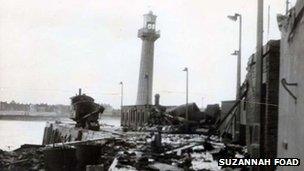Flood of 1953: Memories from Kent
- Published

Police went to the aid of people trapped in the homes along King Street in Margate
On the evening of 31 January 1953, the Kent coast was hit by a storm surge which had swept down the eastern coast of England causing death and destruction.
No lives were lost in Kent on that night, but hundreds died further north in some of the worst storms ever recorded.
Doreen White, from Herne Bay, remembers the storm arriving.
"It gradually got rougher and windier and rougher and windier and the tide was coming up and up and up. It was obvious what was going to happen," she said.
"We were too busy to be frightened, filling up sand bags to block up doorways. Everyone was working like mad."
'In for trouble'
High tides, strong winds and low air pressure combined to raise sea levels in the North Sea and send a storm surge with up to 20ft (6m) waves south along the coast.

The lighthouse in Margate disappeared into the sea
Sea defences were breached and water surged through the streets of coastal towns flooding thousands of low-lying homes.
About 5,000 acres of farmland was covered by the sea water, and thousands of animals died in the flooding.
Sarah Pout, who was 10 years old at the time, said: "Even by about four o'clock in the afternoon we realised it was going to be something pretty horrendous."
She still lives in the same house next to Whitstable beach.
"If the tide was at full high tide mark, four hours before high tide was due you knew you were in for trouble," she said.
"About 11 or 12 o'clock [midnight] the electricity went off because the water had flooded across the marshes at Seasalter.
"We had little gas lamps and I can still hear them now as they made a hissing noise.
"We opened the windows so the sea wouldn't break the glass and just sat and waited."
Ted Edwards, a flood defence engineer from Canterbury City Council, said the flood barriers were not very high along the north Kent coast and were built to give people jobs during the Great Depression between the two world wars.
"It broke through the northern sea wall at Seasalter and it flooded from Reculver and met with flooding from Sandwich," he said.
'Absolute mayhem'
Mr Edwards said the Isle of Thanet - which was once separated from the Kent mainland by the Wanstum Channel until it silted up in the 1600s - was "virtually cut off again".
As a boy, Mick Tomlinson witnessed the storm surge that night as it destroyed the lighthouse on the end of Margate's stone pier.
"Everybody realised, they saw this thing rocking from side to side."
Mr Tomlinson, who went on to become twice-mayor of Margate, said: "You expected something to happen. It was loose, something had gone and over it went.
"It didn't just crumble, it slowly went down and into the sea.
"It was as like a giant had just swept things aside. It was absolute mayhem."
The flood water washed labels off the bottles of beer at the local pub's cellar and tins of food in people's homes, Mrs White said.
"You didn't know what you were opening for weeks afterwards," she said.
"Once the water had gone away, that was not the end of it. That's when the worst part starts."
- Published29 January 2013
- Published12 January 2013
- Published12 September 2011